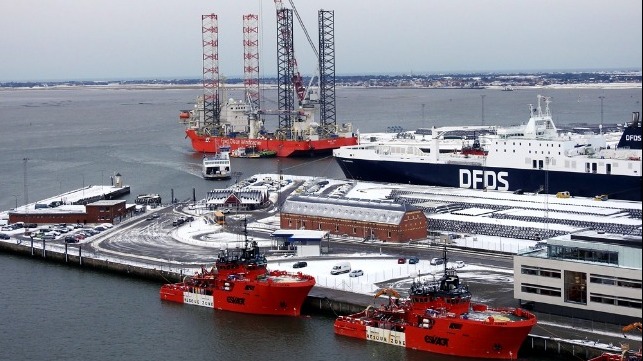Danish Port Targets 70 Percent Carbon Reduction Using Wind Energy

In a first for the maritime industry, a Danish port is on track to achieve a 70 percent reduction in carbon emissions through the use of renewable offshore wind energy and an energy management system. Port Esbjerg, located on the southwest coast of Denmark, is working with Honeywell on a comprehensive carbon and energy management program linked to Denmark’s goals for decarbonization.
Port Esbjerg recently inaugurated its first shore-to-ship power units, which allow docked vessels to run on renewable electricity from offshore wind turbines, instead of using onboard diesel generators. The shore-to-ship units can simultaneously power multiple large vessels, and the port can plan and manage the operations and emissions through a system that estimates vessels’ carbon footprint and can assist in reducing noise pollution.
“Given the size and complexity of our operation, there was no simple, off-the-shelf solution for our green transition,” said Port Esbjerg CEO, Dennis Jul Pedersen. “We worked with Honeywell to fully customize a system that can monitor energy consumption and emissions, as well as pinpoint potential improvement opportunities.”
The Honeywell Enacto Carbon and Energy Management system is cloud-based and enables the port to monitor the emissions and resource consumption of every individual power socket, and every vessel. The system uses artificial intelligence and machine learning algorithms in conjunction with data collection from energy-consuming or -producing assets at the port.

that matters most
Get the latest maritime news delivered to your inbox daily.
If consumption changes significantly, the system sends an automated message to the port office, meaning any abnormalities are immediately identified and action may be taken. Vessels’ carbon emissions are closely observed with the aim of reduction through operational investments in sustainable infrastructure, including the use of renewable energy, and in the future clean fuel technology. Based on the data generated, Port Esbjerg can optimize its energy and carbon footprint in real-time.
In the next phase of the project, Port Esbjerg and Honeywell will monitor and manage water consumption and heating, as well as the emissions' performance of businesses around the port. The plan also features significant investments in electric vehicle technology and hydrogen-powered cranes. The target is for all port vehicles to be powered by electricity by 2025.
